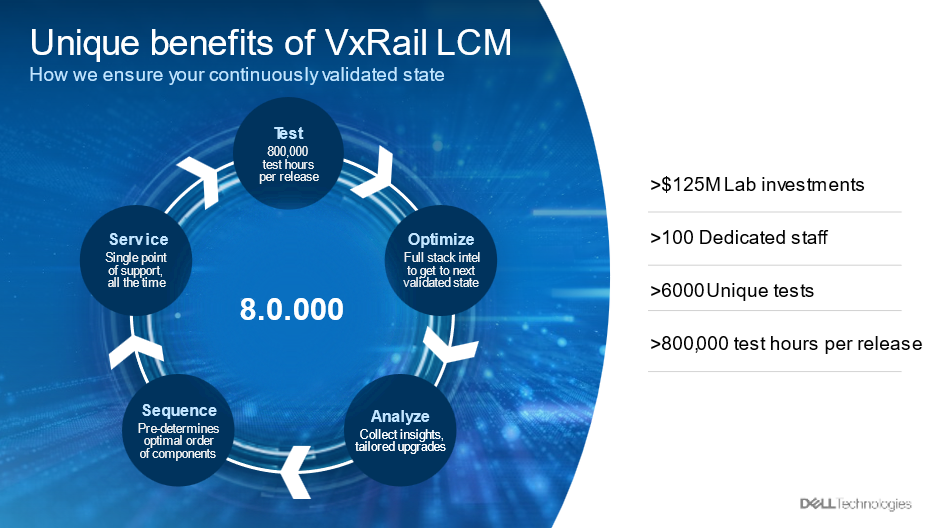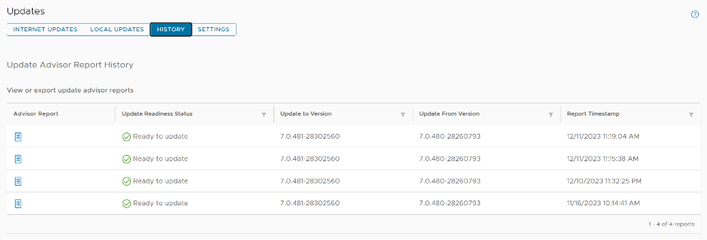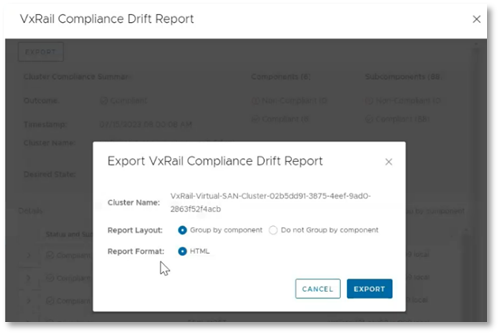

Empowering Cloud-based Multi-cluster Management Using VxRail with CloudIQ
Fri, 18 Aug 2023 23:01:25 -0000
|Read Time: 0 minutes
Introduction
In today's digital landscape, organizations across various industries are generating and accumulating amazing sums of data. To harness the potential of this explosive data growth, businesses heavily rely on cluster computing. Managing these clusters effectively is critical to optimizing performance and ensuring continuous operations. VxRail clusters provide massive amounts of automation right out-of-the-box, which helps administrators accomplish significantly more.
But as the number of clusters grows, a centralized management interface becomes more and more valuable. That’s why I wanted to talk to you about CloudIQ today and introduce three exciting new features:
- Support for 2-node and stretched vSAN clusters
- DPU monitoring
- Performance anomaly detection with historical seasonality
These advancements revolutionize cluster management because they offer enhanced efficiency, flexibility, and performance to meet the evolving needs of modern enterprises.
The evolution of cloud-based cluster management
Traditional on-premises cluster management frequently presents challenges with hardware maintenance, scalability issues, and costly infrastructure investments. Cluster management with CloudIQ has proved to be a game-changer, allowing businesses to centralize the management of hardware and infrastructure to a single cloud-based tool.
By combining VxRail automation with CloudIQ, enterprises can focus on optimizing their applications and workflows while more easily handling cluster provisioning, scaling, and maintenance. This paradigm shift not only improves resource allocation and utilization. It also enables organizations to adapt more quickly to dynamic workloads.
2-Node and stretched vSAN cluster support for CloudIQ
In response to diverse business needs, CloudIQ now supports two additional cluster deployment types: the 2-node and stretched vSAN clusters.
2-Node Clusters
Traditionally, clusters required a minimum of three nodes to maintain high availability, because having an odd number of nodes helped avoid split-brain scenarios. However, 2-node clusters can also address this challenge and ensure fault tolerance and high availability.
2-node clusters use advanced quorum mechanisms, allowing them to make decisions efficiently despite the lack of a third node. The nodes in the cluster communicate with each other and decide on quorum, based on various factors like network connectivity, storage health, and other cluster components. This setup significantly reduces infrastructure costs and is ideal for small to medium-sized businesses that require robust cluster management without the expense of additional nodes. 2-node clusters populate in the same location in CloudIQ as the rest of your clusters. They can be found by selecting the Systems option under the Monitor tab. After you select Systems, select the HCI inventory option and your enrolled VxRail clusters will populate there.
Stretched vSAN clusters
Businesses often want to deploy clusters across multiple geographically distributed data centers to improve disaster recovery and enhance business continuity. Stretched VxRail clusters with vSAN provide an excellent solution by extending vSAN technology across multiple data centers.
Key benefits of stretched VxRail clusters with vSAN include:
- Disaster Recovery: By replicating data between data centers, these clusters protect against site-wide outages, ensuring that operations continue seamlessly in case of a data center failure.
- Load Balancing: Stretched clusters intelligently distribute workloads across different data centers, based on demand, to optimize resource utilization and performance.
- Data Locality: Organizations can maintain data locality to comply with regional data regulations and reduce data access latency for end-users across different geographical regions.
Data Processing Unit Reporting
In a clustered environment, data processing units (DPUs) can become critical for efficient resource management. DPUs are hardware accelerators designed to handle specific data processing tasks, like NSX and other tasks handled by the vSphere Distributed Services Engine, to enhance overall cluster performance for specific workloads.
The Data Processing Unit Reporting feature provides insight into the details of DPUs within the cluster. Cluster administrators can view the hardware information for each DPU, including: the host name of each server with a DPU, the model, the OS version running on the host, the slot the DPU is installed in, each DPU’s serial number, and their manufacturer.

Performance Anomaly Detection
Unanticipated performance fluctuations can significantly impact application responsiveness and overall user experience. To address this concern, CloudIQ now integrates Performance Anomaly Detection—an intelligent monitoring feature that proactively identifies performance issues as they develop.
How does Performance Anomaly Detection work?
This feature uses machine learning algorithms to establish baseline performance patterns for various cluster metrics, including CPU utilization, memory utilization, power consumption, and networking.

When configured, the system continuously monitors real-time performance metrics and compares them to the baseline.
When CloudIQ detects any deviations from the expected behavior, it can raise alerts, enabling administrators to investigate and rectify potential problems immediately. This proactive approach ensures that performance issues are addressed before they affect critical operations, reducing downtime and enhancing user satisfaction.
Conclusion
As the demand for efficient data processing and storage continues to grow, cloud-based cluster management becomes vital for modern enterprises. The introduction of 2-node and stretched vSAN cluster support, data processing unit reporting, and performance anomaly detection takes cluster management to new heights. By leveraging the cutting-edge features of CloudIQ with VxRail, business organizations can unlock unparalleled efficiency, scalability, and performance, gaining a competitive advantage in today's fast-paced digital landscape. Embracing cloud-based cluster management with CloudIQ and its new features will undoubtedly pave the way for a bright and productive future for organizations and industries of all sizes.
Author: Dylan Jackson
Related Blog Posts

Impacting the World, One Happy Customer at a Time
Fri, 25 Aug 2023 21:45:55 -0000
|Read Time: 0 minutes
As I get back from a lovely week to relax and reset by the beach in Mauritius, I have had time to realize that sometimes the important thing to do is to find time to relax and rejuvenate. I have come back with a burst of energy ready to get back to doing what I love most – spending time helping customers build simple Infrastructure solutions.
As a core member of the Dell Technologies infrastructure solutions sales team, I have come to realize that our core job is to solve problems. All businesses today are out there solving customer problems and challenges, either by producing goods or delivering services. Most businesses today have a lot of behind-the-scenes challenges to overcome to be able to help their customers.
 Technology plays a big part in everything we do today, and IT teams must be on top of their game all the time to ensure businesses can continue to focus on what’s important – Customers!
Technology plays a big part in everything we do today, and IT teams must be on top of their game all the time to ensure businesses can continue to focus on what’s important – Customers!
I have had the opportunity to work with a non-profit organization that is literally making the world a better place for everyone globally. The work they do is non-stop and it is not easy. Their work requires an immaculate IT setup that needs to be always online, secure, and able to scale for their bespoke applications. Their current setup has gone through some major changes in terms of their applications and tracking methodologies. They had been experiencing multiple information and data silos, complexity in infrastructure management, and data security issues. In helping them find a way to simplify their IT, we too played a part in making the world a better place.
We had a few conversations and agreed that we needed to build the entire infrastructure on one platform. In this case, VMware was the unanimous choice. The two biggest challenges were to eliminate silos and to simplify management. HCI was the best way to achieve both, and we chose VxRail HCI systems. This solution went on to deliver a consistent platform across the edge, core, and cloud. It has proven to be a solution that can that manage all of the compute, storage, and networking resources through a single pane of glass with vCenter -- all under a single support umbrella for all of the hardware and software deployed.
Lifecycle management with BIOS, firmware, and software updates and upgrades can be a painful and time-consuming process. But what if I told you we can automate these tasks with one-click upgrades, one node at a time without any downtime – how does that sound? When I asked, the CTO was happy, and the IT manager was happier. All those investments in our R&D labs with over 100 people working on resolving some of the most common challenges -- like upgrades for IT teams around the world -- now made sense.

What made the solution choice easier was the ability to remotely monitor it from anywhere in the world with Cloud IQ, and its ability to scale and grow, not just on premises but in the cloud, any cloud at any time.
Did we manage to resolve their IT challenges - Yes, with a simplified solution like VxRail that provides performance, management simplicity, automation of tasks, and the flexibility to grow and scale. The customer was delighted - knowing full well that they now have an infrastructure setup that helps them do all the work they do consistently, and to be able to expand their work to different Geo Regions as well.
At the end of it all did I enjoy my time off after helping build an infrastructure solution for an organization doing something so meaningful. While I was away, I did get a postcard from the IT manager who was able take his wonderful family out for a nice little vacation, knowing that he could easily manage anything he needed to from anywhere in the world.
On to helping our next customer get the same peace of mind so they can leave their mark on the world too.
Author: Manish Bajaj

A Closer Look at New Features Brought with VxRail 7.0.480
Sat, 17 Feb 2024 23:57:31 -0000
|Read Time: 0 minutes
The landscape of VxRail software is ever-evolving. As software releases become available, so too do new features and functions. These new features and functions create a more robust ecosystem, focusing on simplifying regular tasks that appear mundane but are critical to maintaining a secure, up-to-date, and healthy IT environment. VxRail 7.0.480 brought several new and enhanced capabilities to administrators, continuing to build on the streamlined infrastructure management experience that VxRail offers. Many of these improvements are part of the LCM experience. Let’s take a moment to discuss some of these new software improvements and what they can do for infrastructure staff. These include expanded storage of update advisor reports from one report to thirty reports, the ability to export compliance reports to preservable files, automated node reboots for clusters, and extended ADC bundle and installer metadata upload functionality for improved prechecking and update advisor reporting.
Extended update advisor report availability
Administrative teams have likely seen various update advisor reports. These reports have been part of the VxRail LCM experience for the past few releases and present a look at the Figure 1. A view of the pane showing multiple update advisor reports available for review cluster as it is at the moment. That said, storing multiple reports helps provide a documented history of the cluster. VxRail 7.0.480 has taken these singular reports and extended their storage to hold up to thirty reports, granting administrators the information and reporting to review up to the last thirty updates.
Figure 1. A view of the pane showing multiple update advisor reports available for review cluster as it is at the moment. That said, storing multiple reports helps provide a documented history of the cluster. VxRail 7.0.480 has taken these singular reports and extended their storage to hold up to thirty reports, granting administrators the information and reporting to review up to the last thirty updates.
Imagine that you have a large cluster. Different nodes could need different remediating actions. The ability to maintain multiple reports would enable administrators to address issues raised in a report while also creating a documentation trail for when corrective actions take multiple administrative cycles spanning extended lengths of time, possibly exceeding a day.
Export of compliance drift reports
Compliance drift reports are another reporting element of the LCM process, helping administrators to ensure that clusters conform with a Continuously Validated State (CVS) on a daily basis. This frees up administrators to attend to business-specific tasks, while ensuring that the more mundane work of gathering software versions for review is automated. This is a critical task that helps prevent time-intensive infrastructure issues that IT teams need to dedicate resources to correcting. Additionally, these reports ensure that LCM updates are successful by identifying any components that may have drifted from what is defined by the current Continuously  Figure 2. The option to export a drift report to a local HTML fileValidated State.
Figure 2. The option to export a drift report to a local HTML fileValidated State.
These compliance drift reports, demonstrated to the right, can now be exported, aiding administrators in creating and maintaining a documented history of their clusters' adherence to Continuously Validated States. Each report can be grouped by components and is saved to an HTML file, preserving the original view that VxRail administrators have come to know.
Sequential node reboot
Our next new feature automates the sequential reboot of nodes within a cluster, a task that many customers engage in manually. The automatic node reboot function is found within the Hosts submenu in the Configure tab. As shown in the following demonstration, administrators simply select the nodes they want to reboot, click the reboot button, and then complete the wizard. The wizard offers the options to begin rebooting immediately or schedule them for a later time. Once this selection is made, the wizard will run a precheck, and the reboot cycles can begin. While this feature most benefits larger clusters, clusters of any size are advantaged by automating infrastructure tasks. Node reboots can help further improve update cycle success rates by clearing issues like memory utilization or restarting any potentially hung processes.
As an example, let’s consider memory utilization again. If there were an issue with the balloon driver making memory available, the update precheck would detect it, however rebooting the node would restart the service and force the memory to be made available once again. We’ve also observed cases where larger clusters are updated less often compared to smaller clusters due to longer maintenance windows. This can lead to longer times between reboots for larger clusters. The sequential reboot of nodes within a cluster eases the difficulty in restarting larger clusters through automation and orchestration, leading to restarts with minimal administrator activity. This can clear a variety of issues that could halt an upgrade.
That said, manually rebooting each node within a cluster can require a significant time investment. Imagine for a moment that we have a 20-node cluster. If it took just 10 minutes per node to migrate workloads away from a node, restart the host, bring it back online physically and relaunch software services, and finally bring workload back, cycling through all 20 nodes would still take over three hours of an administrator's undivided attention and time. In reality, this reboot cycle would likely take longer. Automating these actions allows clusters to benefit from these actions while freeing IT staff up to focus on other critical business tasks.
ADC bundle and installer metadata upload
VxRail 7.0.480 brings the ability to use the adaptive data collector (ADC) bundle and installer metadata, shown being uploaded in the following demonstration, to update the LCM precheck and update advisor functions VxRail Manager provides. This is helpful because the precheck routinely welcomes new developments, leading to a more robust precheck and more successful LCM update cycles. For example, one of the more recent precheck developments involves an additional check on memory utilization. The LCM precheck examines CPU and memory utilization of the vCenter Server appliance. If either CPU or memory utilization exceeds an 80% threshold, a warning will appear in the precheck report. If the check occurs as part of an upgrade cycle, then the warning appears in the update progress dashboard. The update advisor metadata file includes all the version information related to the target VxRail release version. This allows the update advisor to create reports showing the current, expected, and target software versions for each LCM cycle. These packages are pulled by VxRail Manager automatically over the network for clusters using a Secure Connect Gateway connection and are also available to offline dark sites using the Local Updates tab.
Conclusion
The VxRail engineering team routinely delivers new features and functions to our customers. In this blog, we reviewed the enhancements for expanded update advisor report storage, the ability to export drift reports to local HTML files, automated cluster node reboot cycles, and the enhanced LCM precheck and update advisor with the ADC bundle and installer metadata file uploads. As we move forward, we continue to enhance LCM operations and minimize the time required to manage VxRail. As such, VxRail is a fantastic choice to run your virtualized workloads and will continue to become a more robust and administration-friendly platform.
Author: Dylan Jackson, Engineering Technologist


